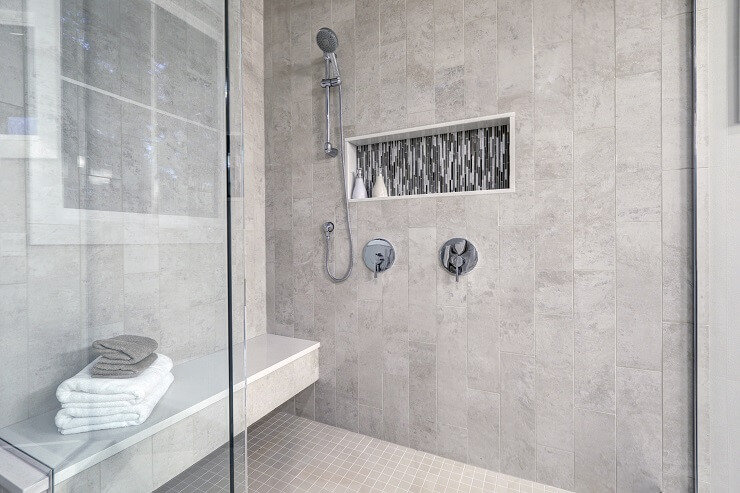Why settle for a standard bathroom when you can elevate it with a floating shower bench?
This compact luxury not only enhances your space’s functionality but also introduces an element of modern design.
This comprehensive guide is your go-to resource for how to build a floating shower bench, from selecting the right materials to understanding its pros and cons.

Floating Shower Bench Pros
All shower benches have some common benefits, the most common being sitting and relaxing while taking a shower.
It also enhances your bathroom design and can improve the quality of your bath experience.
A floating shower bench, however, has its distinctive benefits, some of which include:
Space Management
This is one of the most common reasons why people choose floating shower benches over the built-in ones.
If you have a small bathroom space and still want to include a shower bench, your best option will be the floating shower bench, as it will not steal extra space.
Storage
Floating benches have space underneath that can be used to store other items and help you declutter easily.
Small items such as your shampoo bottles, shower gel, scrubs, or other cosmetic products can go underneath the bench.
It can also be a great space to keep wheelchairs for those who use them.
Besides, it allows for more leg space when you sit and keeps you comfortable.
Design
Floating shower benches add an extra feel and look to your bathroom space even better if you get creative with your designs.
The design may also depend on the kind of material used for the surface.
Floating Shower Bench Cons
While floating shower benches may have their benefits, there are also some downsides you must know:
Aesthetics
As much as the feel and look of floating shower benches depend on you, they usually do not look as lovely as built-in benches.
This is because built-in benches are often incorporated into the bathroom design and are a natural fit.
Floating benches, on the other hand, are mostly an afterthought and are placed separately.
If you would opt for a floating shower bench, find a way to incorporate it nicely to blend in perfectly and not feel out of place.
Risk of Injury
If it’s not installed correctly, a floating shower bench can pose a risk of injury to the user.
Ensure the seat is sturdy and holds the weight up to 400lbs, so it doesn’t fall off when it carries extensive weight.
Also, ensure it is appropriately installed into wall studs.
Moisture and Molds
Since floating shower benches are often incorporated after the bathroom is set up, you will have to drill into your shower tile.
This may let moisture into the drilled area, especially if the installation is not correctly done.
Over time, this moisture will begin to form molds and mildew.
Floating Shower Bench Materials
You can design your floating shower bench to taste, and one of the ways to do that is by choosing your materials carefully.
Shower bench materials range from stone options such as marble, granite, and quartz to wood options such as teak and bamboo.
Your choice of material would depend on your preferred design, budget, and level of maintenance.
Bamboo and teak are now commonly used for shower benches because they are cheaper and naturally water-resistant, but a processed bamboo bench might need chemical treatment to keep it in place.
On the other hand, stone is much more expensive than wood, but it is durable and has a longer life.
It also requires less maintenance than wood.
How to Build a Floating Shower Bench
There are different kinds of floating shower benches, which means they cannot be built the same way.
However, there are some general installation tips everyone should know while installing a floating shower bench. This includes:
- Choose a water-resistant material that is sturdy and supportive.
- Ensure the bench is installed correctly into the wall studs to avoid moisture getting into the drilled holes.
- Decide how high the bench should be and where it should be installed based on a proper measurement. There may be a difference between the heights of benches in children’s and adult’s bathrooms.
- Use wall anchors in the drilled holes to ensure the bench stays intact.
- Seal off any extra holes with a waterproof filler and sealant. This will prevent moisture from getting in and forming molds over time. Additionally, you can use it on the upper edge of the bench to seal any holes.
FAQ
Shower bench dimensions could depend on your bathroom and who uses the bench. However, the Americans with Disabilities Act (ADA) recommends using a height of 17 inches (430 mm) minimum and 19 inches (485 mm) maximum.
The depth should not exceed 15-16 inches, but it must not be so deep that it is hard to stand up. The length should depend on how much space you have available. The general rule is to ensure users are comfortable on the bench.
A shower bench’s average weight capacity is 200 to 500 pounds, but a floating bench must hold at least 400lbs.
Whether or not you will need additional waterproofing would depend on your choice of material. With marble, granite, and quartz, you don’t need additional waterproofing since they are already water-resistant. However, if you opt for wood like teak or bamboo, you may need an extra waterproofing layer.
While teak holds up moisture better, bamboo in its processed state is not that water-resistant. You can install a shower pan liner or a liquid polyurethane coating such as Permaflex to waterproof the bench or the entire shower.

